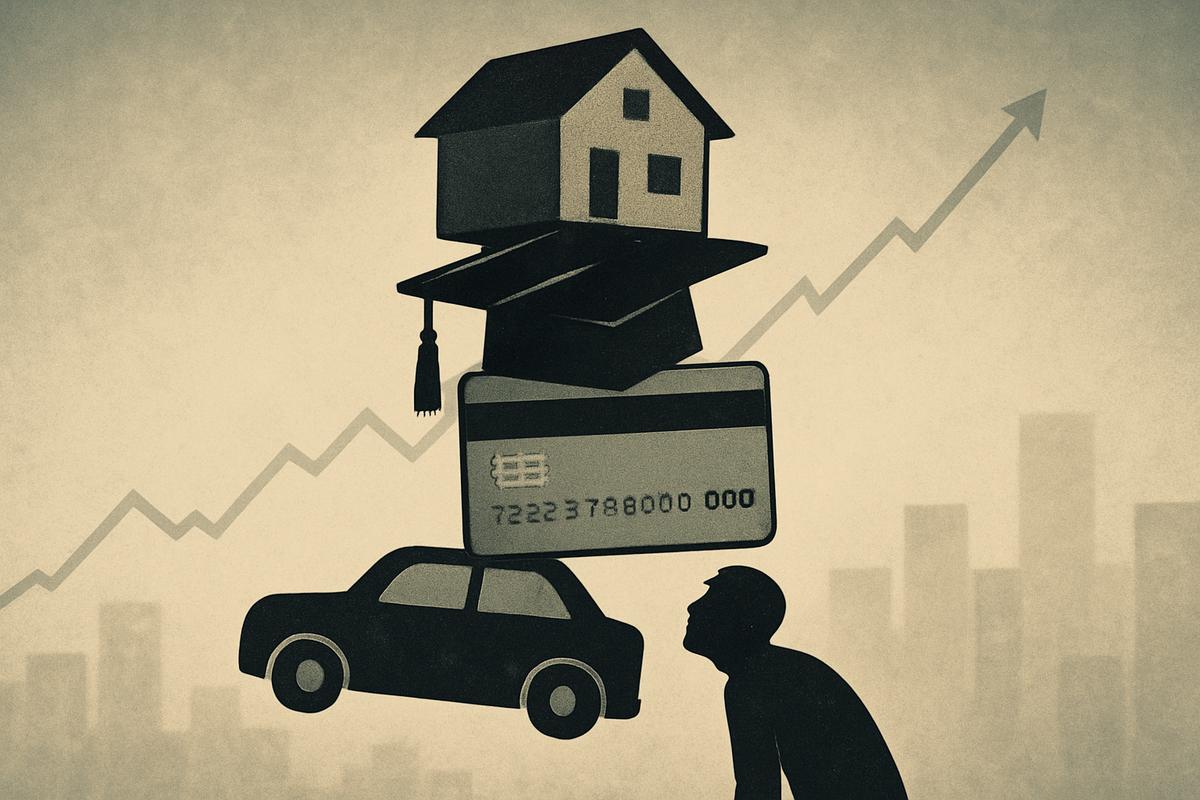
Washington D.C. – November 6, 2025 – The financial landscape of the United States is at a critical juncture as U.S. household debt has surged to a record-shattering $18.59 trillion in the third quarter of 2025. This unprecedented level, driven by substantial increases in mortgage, credit card, student, and auto loans, presents a complex web of immediate implications for the nation's economy, from potentially slowing consumer spending to complicating the Federal Reserve's delicate policy balancing act.
The $197 billion (1.07%) increase from the previous quarter, and a staggering $4.4 trillion rise since the end of 2019, paints a picture of consumers increasingly relying on credit. While the aggregate figures might suggest resilience, a closer look reveals a bifurcated reality where many households, particularly younger and lower-income demographics, are grappling with elevated financial stress and rising delinquency rates, setting off warning signals for potential economic deceleration and heightened financial vulnerability.
A Deep Dive into America's Expanding Debt Portfolio
The record-breaking $18.59 trillion in U.S. household debt as of Q3 2025 is a culmination of sustained growth across almost all major debt categories. This surge reflects a period marked by persistent inflation, aggressive monetary tightening cycles, and the lingering economic adjustments post-pandemic.
Mortgage Debt, the largest component, rose by $137 billion (1.06%) to an all-time high of $13.072 trillion. New mortgage originations reached $512 billion in the third quarter, indicating continued, albeit perhaps slower, activity in the housing market. Despite the growing balances, mortgage delinquency rates have remained relatively low and stable, even seeing a slight decrease in transitions into serious delinquency, largely attributed to stringent underwriting standards and substantial home equity held by homeowners.
Credit Card Debt has seen a dramatic ascent, climbing by $24 billion (1.99%) in Q3 2025 to a record $1.233 trillion. This represents a nearly 6% increase year-over-year and a substantial 60% increase since its pandemic-era low in Q1 2021. The average Annual Percentage Rate (APR) for credit cards accruing interest has also soared to 22.83%, placing significant financial strain on millions of cardholders. The serious delinquency rate for credit cards reached 12.41%, the highest since 2011, signaling widespread distress, particularly among subprime borrowers.
Student Loan Debt increased by $15 billion (0.92%) to an all-time high of $1.653 trillion. This category has witnessed the most significant deterioration in delinquency rates, with 14.3% of accounts transitioning into delinquency in Q3 2025. Approximately 9.4% of total student loan debt was 90 days or more past due. This sharp increase is largely a direct consequence of the resumption of federal student loan payments in late 2023 and the subsequent reporting of previously paused missed payments to credit bureaus, impacting the credit profiles of millions.
Auto Loan Debt remained steady at a record $1.655 trillion in Q3 2025. While new originations saw a slight dip, average monthly payments for both new and used vehicles have risen considerably. Auto loan delinquency rates, particularly for subprime borrowers, had reached or surpassed Great Recession levels earlier in the year, though the pace of growth in delinquencies has since slowed.
The timeline leading to this moment reveals a trajectory of increasing leverage:
- Q2 2020 - Q1 2021: Pandemic relief and reduced spending led to a temporary dip in credit card debt and a pause in federal student loan payments.
- 2023: Federal student loan payments resumed, setting the stage for future delinquency spikes.
- Q4 2024: Previously unreported federal student loan missed payments began appearing on credit reports, and credit card balances hit a new all-time high.
- Q1-Q3 2025: Total household debt continued its upward climb, with significant increases in credit card and student loan delinquencies, culminating in the $18.59 trillion record.
Key players in this unfolding scenario include consumers, who are increasingly using credit for essential expenses; lenders (banks, credit card companies, mortgage providers), whose practices and risk assessments directly influence debt levels; and government bodies like the Federal Reserve Bank of New York, which tracks and reports on these trends, and the Department of Education, whose student loan policies have had a profound impact. Credit bureaus such as Equifax (NYSE: EFX), Experian (LON: EXPN), and TransUnion (NYSE: TRU) play a crucial role by compiling and reporting credit data, influencing lending decisions.
Initial market reactions have been mixed. While the resilience of the mortgage market is noted, the rapid growth in high-interest credit card debt and the sharp rise in student loan delinquencies are causing concern. Financial institutions are observing increased demand for debt consolidation loans, indicating that many consumers are actively seeking ways to manage their accumulating burdens.
Companies Navigating the Debt Tsunami: Winners and Losers
The record-high U.S. household debt creates a complex environment, presenting both opportunities and significant challenges for public companies across various sectors. While some may initially benefit from higher interest income, the overarching trend of elevated delinquencies and reduced consumer spending signals potential headwinds for many.
Banks (Lenders) face a dual impact. Institutions with strong underwriting standards and diversified income streams are better positioned. For example, JPMorgan Chase & Co. (NYSE: JPM) or Bank of America Corp. (NYSE: BAC), with their broad range of services and robust risk management, might fare better than smaller, less diversified regional banks heavily exposed to subprime lending or vulnerable sectors like commercial real estate. Banks heavily reliant on interest income from riskier loans will likely see increased provisions for loan losses, eroding profitability.
Credit Card Issuers like Visa Inc. (NYSE: V) and Mastercard Inc. (NYSE: MA) could see continued transaction volume, but issuers that primarily target lower-income or subprime segments, such as some smaller credit card companies, will likely experience higher charge-offs and increased loan loss provisions. Companies with sophisticated risk management and analytics, capable of identifying financially stable customers, will have an advantage.
Auto Manufacturers are likely to face headwinds. Companies like General Motors Co. (NYSE: GM) and Ford Motor Co. (NYSE: F) may see decreased demand for new vehicles as consumers prioritize debt repayment over discretionary purchases. The rising cost of vehicles combined with higher interest rates on auto loans makes new car purchases less affordable, particularly for lower-income households. Luxury auto manufacturers might be more insulated, as affluent consumers are less affected by debt burdens.
Student Loan Servicers, such as Nelnet Inc. (NYSE: NNI) or Sallie Mae (NASDAQ: SLM), are in a precarious position. While increased loan volume could mean higher fee-based revenue, the spike in delinquencies means more administrative burden and potential losses from defaulted loans. Servicers with robust debt management and collection processes will be crucial in mitigating these risks.
Retailers face significant challenges as consumer discretionary spending is curtailed. Companies like Target Corp. (NYSE: TGT) or Walmart Inc. (NYSE: WMT) could see shifts in purchasing behavior, with consumers opting for essential goods and value-oriented products over non-essentials. Luxury retailers and those heavily dependent on high-margin discretionary items are particularly vulnerable. Discount retailers and essential goods providers may see increased demand as consumers become more budget-conscious. Companies with strong e-commerce platforms and efficient supply chains may adapt better to these shifts.
Wider Significance: A Shadow Over Economic Stability and Federal Reserve Policy
The record high U.S. household debt of $18.59 trillion casts a long shadow over the broader economic landscape, intertwining with existing industry trends, creating ripple effects, and profoundly influencing the Federal Reserve's policy decisions. This situation is not merely an isolated financial statistic but a critical indicator of underlying economic stress.
This escalating debt fits into a broader trend of increased leverage across the economy, although the composition of household debt has evolved since previous peaks. While mortgages still dominate, the significant rise in student and auto loans highlights a shift in consumer borrowing patterns. Industries heavily reliant on consumer discretionary spending are now highly vulnerable. Retailers, consumer goods manufacturers, and even parts of the housing and automotive sectors face potential headwinds as consumers divert more income towards debt servicing rather than new purchases.
The ripple effects extend beyond direct lenders. Supply chains can be disrupted as reduced consumer demand leads to lower orders for manufacturers and suppliers. Businesses, facing declining sales, may delay investments or hiring, further dampening economic growth. The competitive landscape could shift, favoring companies with more resilient customer bases or those offering essential goods and services.
For the Federal Reserve, the record household debt presents a formidable policy challenge. The central bank must balance its dual mandate of maximum employment and price stability against the backdrop of growing household financial strain. While the Fed initiated its first interest rate cut of 2025 in September, bringing the federal funds rate to 3.75%-4.00%, and ceased quantitative tightening, further easing is anticipated to support a cooling labor market. However, aggressive rate cuts risk reigniting inflationary pressures, which are already expected to reaccelerate modestly in 2025 and 2026 due to tariff headwinds. Conversely, higher interest rates further burden indebted households, threatening to stifle investment and consumer spending. The Fed's Financial Stability Report will continue to closely monitor vulnerabilities, particularly the concentrated stress among subprime borrowers, to prevent broader systemic risks.
Historically, comparisons to the 2008 financial crisis offer crucial insights. While the nominal total household debt in Q3 2025 surpasses the 2008 peak, current debt levels are slightly below their Q1 2009 peak when adjusted for inflation. A key difference lies in mortgage quality; underwriting standards are generally tighter today, and homeowners often have substantial equity, contributing to lower mortgage delinquency rates. However, the current concern is more diversified, with credit card and student loan delinquencies being particularly elevated. The lessons learned from 2008 underscore the dangers of excessive leverage and the need for robust financial sector regulations to moderate household debt growth.
What Comes Next: Navigating a Period of Uncertainty
The path forward for the U.S. economy and financial markets, in light of record-high household debt, is fraught with both short-term adjustments and long-term implications. The interplay of monetary policy, inflation, and consumer behavior will dictate the trajectory.
In the short-term (late 2025 - 2026), the U.S. economy is projected to experience a deceleration in real GDP growth, with forecasts around 1.7% for 2025 and 1.4% for 2026. This slowdown is largely attributed to tariff headwinds, ongoing policy uncertainty, and the delayed effects of elevated interest rates on business investment and household consumption. While the Federal Reserve has begun to ease monetary policy with an interest rate cut in September 2025 and the cessation of quantitative tightening, analysts caution that lower rates alone may not fully alleviate the burden of existing high-interest debt, potentially inflating a consumer debt bubble. Consumer spending, while showing resilience in some areas, faces a significant threat from the growing weight of credit card debt, particularly for lower-income households increasingly using credit for daily essentials. The labor market is also showing signs of softening, with job creation slowing and the unemployment rate rising to 4.3% in Q3 2025, which could further exacerbate financial strain.
Looking at the long-term (2027 and beyond), while some projections anticipate a rebound in GDP growth, this optimism is significantly tempered by the escalating federal debt, which is projected to reach 107% of GDP by 2029. High levels of household debt, if interest rates remain elevated, will continue to act as a drag on future GDP growth as households prioritize debt repayments over consumption. The immense national debt could also lead to "fiscal dominance," where the Federal Reserve faces pressure to keep interest rates low to manage government borrowing costs, risking renewed inflation.
Potential Strategic Pivots will be crucial across all sectors. Consumers are increasingly seeking debt consolidation and refinancing options, becoming more value-conscious in their spending. Businesses will need to prioritize stringent cost management, diversify supply chains, and invest heavily in innovation and AI to enhance efficiency. Financial institutions may tighten lending criteria, focusing on robust risk management and diversified income streams. Policymakers will face pressure to contain inflation while strengthening fiscal positions, with enhanced transparency on debt data informing targeted consumer protection initiatives.
Market opportunities may emerge in debt management and recovery services, as well as in resilient sectors like healthcare and infrastructure. Value-oriented retailers and companies with strong pricing power may also fare better. Conversely, challenges include reduced consumer spending on discretionary items, increased credit risk for financial institutions, and market volatility driven by policy uncertainty and inflation.
Potential scenarios range from a measured slowdown and gradual rebound (most likely), where the Fed's actions provide some relief but growth remains constrained by national debt, to an accelerated recovery if inflation softens quickly, allowing for more aggressive easing. However, a downside scenario of stagflation or recession remains a tangible risk, especially if tariffs lead to persistent inflation while a weakening labor market and spiraling household debt trigger broader financial distress. The Congressional Budget Office estimates a 40% probability of a recession within the next 12 months.
Wrap-Up: A Delicate Balance Amidst Mounting Debt
The record-high U.S. household debt of $18.59 trillion in the third quarter of 2025 represents a critical juncture for the American economy. While aggregate household balance sheets may appear robust on the surface, a deeper examination reveals a growing financial strain for specific demographics, particularly younger and lower-income borrowers, who are increasingly struggling with high-interest credit card and student loan debt.
The key takeaway is a bifurcated economy where the resilience of the mortgage market, underpinned by stringent underwriting and ample home equity, stands in stark contrast to the rapidly deteriorating conditions in credit card and student loan portfolios. The sharp rise in delinquencies in these latter categories, especially for student loans following the resumption of federal payments, signals a significant vulnerability that could ripple through the financial system.
Moving forward, the market will be characterized by a delicate balancing act. The Federal Reserve's recent pivot to interest rate cuts aims to alleviate some pressure on indebted households and support a cooling labor market. However, the persistent threat of inflation, exacerbated by potential tariff-induced price increases, limits the Fed's room for aggressive easing. The burgeoning national debt further complicates this picture, raising concerns about "fiscal dominance" and its long-term implications for economic growth and stability.
The lasting impact of this record debt could be a period of slower economic growth as consumers prioritize debt repayment over consumption. It also highlights the importance of robust financial regulations and targeted consumer protection initiatives to prevent widespread financial distress.
For investors, the coming months demand vigilance. Key indicators to watch include:
- Delinquency rates: Pay close attention to any further acceleration in student loan and credit card delinquencies, as these are bellwethers for broader consumer financial health.
- Federal Reserve policy: Monitor the Fed's interest rate decisions and forward guidance, as these will directly influence borrowing costs and market liquidity.
- Consumer spending patterns: Observe shifts in consumer behavior, particularly among lower-income households, as a slowdown in discretionary spending could signal broader economic deceleration.
- Labor market trends: A weakening job market would exacerbate repayment challenges for indebted households.
- Housing market stability: While currently resilient, any signs of weakness in the housing sector could have significant ripple effects due to its large share of household debt.
The current era of record household debt necessitates a prudent and informed approach from all stakeholders. While the aggregate picture may appear stable, the underlying vulnerabilities, particularly among specific demographic groups and certain debt types, will undoubtedly influence market dynamics and Federal Reserve actions in the foreseeable future.
This content is intended for informational purposes only and is not financial advice






